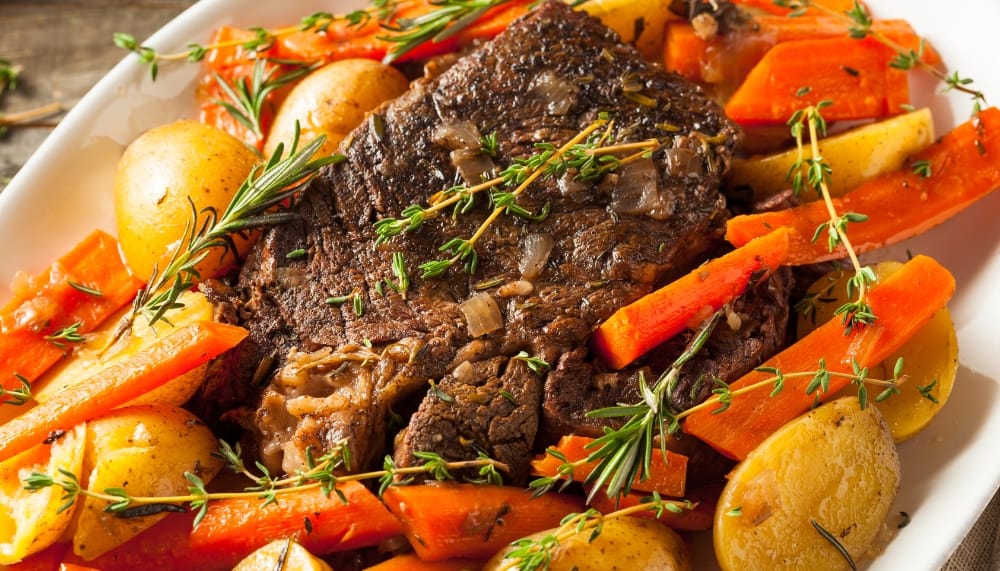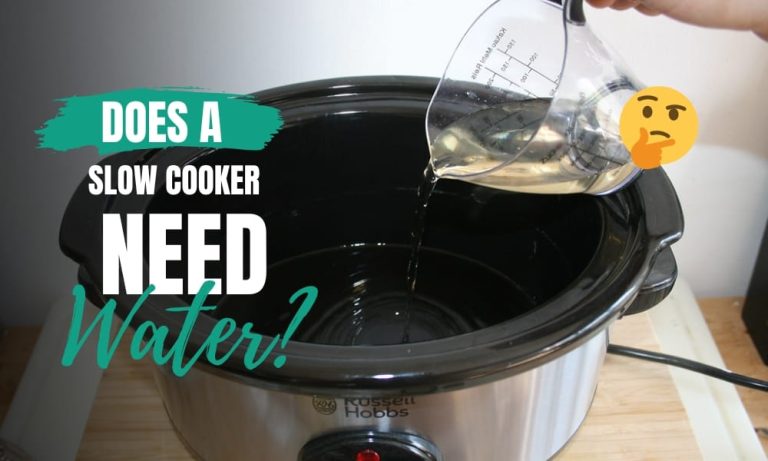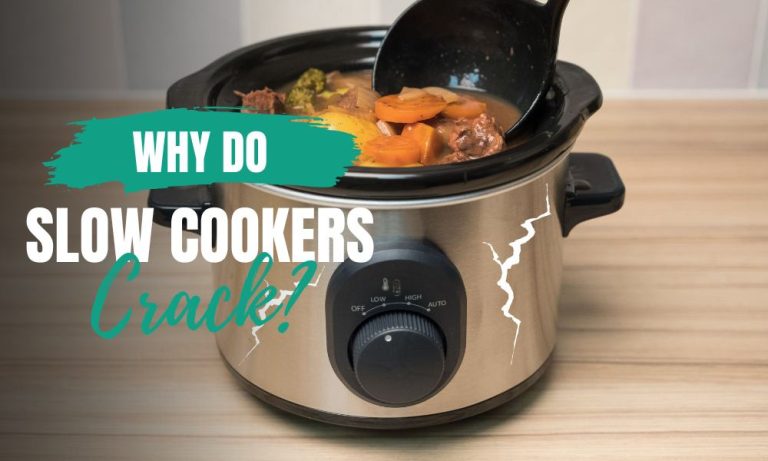Too Much Liquid in Slow Cooker? Is It Healthy? How to reduce it?
Are you looking for ways to reduce the liquid in your slow cooker meals? Or do you suddenly realize there is too much liquid in the slow cooker when you start cooking? If so, you’re in luck! Today I will tell you all you need to know regarding how to reduce the liquid in slow cooker.
In this blog post, I will provide easy tips to help you reduce the liquid in your slow cooker dishes. In addition, we will also discuss how all that low liquid will help add to the taste and nutrition of your cooked food.
From selecting the right ingredients to adjusting the cooking time, these tips will help you create delicious meals cooked to perfection. Read on to learn more about too much liquid in slow cooker!
First, we would tell you about the right way to reduce the liquid in a slow cooker in case you by chance add extra water.
Contents
How to Reduce the Liquid in Slow Cooker

Have you ever added too much water to your slow cooker? It can be a frustrating mistake that leaves you feeling like you’ve ruined your meal. Fortunately, there are several ways to reduce the amount of water in your slow cooker and save your dish.
In this blog post, we will discuss how to reduce the water in your slow cooker if you added too much by mistake. We’ll provide tips on how to quickly and easily get your meal back on track. So don’t worry – you can still enjoy a delicious dinner!
If It’s Getting Close to Time, Take Out Some of the Liquid
The best way to reduce the amount of water in your slow cooker if you’ve added too much is to remove some of the liquid. To do this, carefully scoop out some of the broth or sauce using a ladle or spoon.
Try not to take out any of the solids, as this can affect the flavor and consistency of the meal. Alternatively, you can place a few paper towels on top of the liquid and gently press down on them. This will absorb some of the extra moisture.
Finally, you can thicken up the liquid by adding a small amount of cornstarch. Just mix it with a little bit of cold water, add it to the pot, and stir until thickened. Doing this will help to reduce the amount of water in your slow cooker and create a richer, more flavorful dish.
If It’s Too Late, Add More Ingredients
The best way to reduce the amount of water in your slow cooker is to add more ingredients. You can do this by adding more of the same ingredients you already have in your recipe, such as beef, chicken, or vegetables.
If you don’t have extra ingredients on hand, try adding potatoes or rice, both of which are good at absorbing liquid. This will help reduce the amount of water in your dish and make it more flavorful.
Additionally, adding a few tablespoons of flour or cornstarch can also help absorb some of the extra moisture. Once your additional ingredients are added, give them a stir and let the slow cooker continue cooking for the remaining amount of time. Your dish should come out with a delicious flavor and texture.
Why Use Less Liquid to Begin with a Slow Cooker?

The first step is to remember that you should always start with less water. Never use an excess of water, as it will add to your cooking hassle. It will also be inconvenient as it is not that easy to reduce the water quantity afterward though it is possible.
Some of our readers might wonder what the use of low water quantity will be or why we are emphasizing it so much. Here are some perks that would add to your knowledge in this regard.
The Science Behind It
So what is the science behind how to reduce liquid in slow cooker? Yes, using less liquid in your slow cooker is based on science. When cooking on the stovetop, it’s often recommended to use only enough liquid to cover the cooked food. This prevents the food from becoming soggy or overcooked. The same principle holds for slow cookers.
The longer cooking time in a slow cooker allows food to break down and release its natural juices, thus creating its broth. By adding too much liquid, you can end up with soggy, waterlogged dishes with flavors that have been diluted.
It’s important to remember that using less liquid doesn’t mean using any liquid. You should use about 1/4 to 1/2 cups of liquid for every pound of cooked food to get the most out of your slow cooker. This will help to provide enough moisture for even cooking without compromising the flavor of your final dish.
It Gives You More Flavorful Meals
One of the best-kept secrets when using a slow cooker is that you should use less liquid than you would when cooking on the stovetop. Not only will this help to keep your meals flavorful and delicious, but it will also help to reduce your cooking time.
Here, we’ll explore the reasons why you should use less liquid in your slow cooker, as well as some tips on how to adjust your recipes accordingly when dealing with the query of how to reduce liquid in slow cooker.
More Concentrated Flavors

When cooking with a slow cooker, less liquid is required than in traditional cooking methods. This allows the flavors from your ingredients to be more concentrated as the liquid evaporates slowly when cooked on the stovetop or oven. As the slow cooker traps steam and condensation, flavors are intensified and enhanced, providing you with more delicious and intense flavors in your dish.
Additionally, by reducing the amount of liquid used, you can control the consistency of your dish so that it comes out perfectly every time. Whether creating a creamy stew or a fragrant soup, reducing the liquid in your slow cooker will help ensure the dish is flavorful and delicious.
Better Textured Foods
Using less liquid when slow cooking can also help keep food succulent and tasty. Foods cooked with too much liquid can become mushy and unappetizing, but when the correct amount of liquid is used, the flavors can be more concentrated, and the texture of the food can remain much firmer.
This is especially important when cooking meats, beans, and certain vegetables. Slow cooking can make these items softer and more tender, but too much liquid can give them a gummy or slimy texture. To avoid this, use only enough liquid to coat the bottom of the slow cooker without submerging the food.
Fewer Calories
Using less liquid in your slow cooker is a great way to reduce the number of calories in your meals. Slow cooking allows the food to cook in its juices, releasing more of its natural flavor and nutrition than boiling or steaming. The result is meals that are lower in calories and higher in flavor.
By reducing the amount of liquid you use, you can reduce the calories you consume without sacrificing taste. Plus, slow-cooked meals are generally easier to portion control which also helps to reduce your overall caloric intake. So if you’re looking for a way to enjoy delicious meals while staying within your calorie budget, using less liquid in your slow cooker is the way to go!
Season Meat and Vegetables Before Cooking

The benefits of seasoning your food before cooking in a slow cooker are numerous. Above all, it will help you reduce the need for water. Let us explain it thoroughly:
Slow cookers are a great way to make delicious meals with minimal effort. However, many people need to pay more attention to the importance of seasoning their food before they cook it in a slow cooker. Adding the right seasonings can take your slow cooker meals to the next level.
Read on to learn more about the deliciousness that awaits when you season your food before slow cooking it!
Seasoning Improves Taste and Helps Reduce Water Usage
Seasoning your food before cooking in a slow cooker is beneficial for many reasons. Firstly, it helps to improve the dish’s taste and make it more enjoyable. Additionally, seasoning helps reduce the amount of water needed for cooking, which helps to save time and money. It will also be the ultimate answer to how to reduce liquid in slow cooker.
When you season your food, it creates a flavorful crust that seals in moisture and prevents the food from becoming too dry. This helps to retain flavor and nutrients while also reducing water usage. Furthermore, by seasoning your food before cooking, you can control the amount of salt and spices used in your dish.
This allows you to tailor the flavors to suit your taste and create a more enjoyable eating experience.
Reduces Risk of Bacteria
One of the key benefits of seasoning your food before cooking it in a slow cooker is that it reduces the risk of bacteria growth. The heat generated by a slow cooker is not as hot as other cooking methods, meaning that food needs to be properly seasoned to ensure that any potential bacteria growth is killed off.
Adding a generous amount of salt, pepper, garlic, and other herbs and spices to your food will help reduce the chances of bacteria growth during the slow cooking process. Additionally, because seasoning helps bring out the natural flavors in the food, you don’t have to worry about the taste being compromised.
Finally, seasoning your food before slow cooking can be a great way to keep it safe and delicious!
Helps Retain Nutrients

Adding seasonings to food before slow cooking helps retain the nutrients in the food. This is because seasonings provide an additional layer of protection against heat, reducing the loss of vitamins and minerals. Many seasonings are also rich in antioxidants, which can help protect foods from oxidation and the loss of essential vitamins and minerals.
Additionally, seasonings like garlic and onion contain sulfur-containing compounds that have been found to reduce the loss of certain vitamins and minerals during cooking. When seasoning meat, vegetables, or other foods before slow cooking, it is important to consider the type of seasoning used and its potential impact on nutrient loss.
For example, some seasonings may contain high amounts of sodium, which can reduce the overall nutritional value of a dish. When seasoning food for slow cooking, it is best to opt for herbs and spices that will add flavor without significantly impacting the nutrient content of the dish.
Slow cooking is a great way to prepare flavorful and nutritious meals. Seasoning meats and vegetables before slow cooking ensures that all the nutrients remain intact and your dish is as flavorful as possible.
Seasoning Adds Flavor to Foods
When seasoning your food for slow cooking, it is important to consider the types of flavors you would like to incorporate into your dish. Adding herbs, spices, and other flavorful ingredients such as garlic, onion, or pepper can take your slow cooker meal to the next level.
Seasoning helps to bring out the natural flavors in your food, allowing you to create a more flavorful dish. For example, adding rosemary and garlic to a pot roast will help bring out the savory flavor of the meat.
Adding a few slices of lemon to a vegetable soup will add brightness and acidity to the dish. Adding just a few simple ingredients can transform any basic slow cooker dish into a flavorful meal.
The Case for Smaller Pieces in Your Slow Cooker
Slow cookers are a great way to create delicious, healthy meals with minimal effort. But if you want to get the most out of your slow cooker, one key step should be noticed: cutting your ingredients into smaller pieces before adding them to the pot.
Along with less water being the top reason, we’ll explore why cutting meat and vegetables into smaller pieces is an essential part of the slow-cooking process. We’ll look at the benefits of pre-cutting and some tips for doing it properly. So, let’s get started and learn why smaller pieces are the way to go for slow cooker success.
It Will Reduce the Use of Water

Yes, this is the top reason and will relate to the central theme of our write-up. When it comes to slow cooking, one of the most important reasons for cutting meat and vegetables into smaller pieces before adding them to the slow cooker is that it will reduce the amount of water needed.
If you put large chunks of food into the slow cooker, far more water would be needed to cover all of it, making it difficult to reach the desired temperature. By cutting your ingredients into small pieces, you can use less water, which will heat up more quickly, allowing your dish to reach the right temperature faster. Also, using less water will save time when preparing the dish.
The Food will Cook More Evenly.
Cutting your meat and vegetables into smaller pieces is essential if you’re trying to get the most out of your slow cooker. By cutting them up, you’ll ensure that everything cooks evenly. Otherwise, if you put large chunks of meat in, the outside would be overcooked while the center would remain raw.
The same goes for vegetables. This can create an unpleasant texture and flavor that you want to avoid. Additionally, smaller pieces will cook faster than larger chunks, saving you time and energy. Moreover, with smaller pieces, it will be easier to control the heat distribution in your slow cooker so that everything is cooked properly.
So next time you’re prepping ingredients for your slow cooker, consider chopping them into smaller pieces.
You Can Fit More Food in Your Slow Cooker
If you’re using a slow cooker to make a big batch of food, one of the biggest benefits is that you can fit more into the cooker than you would if you just threw everything in without cutting it up. By chopping your meat and vegetables into smaller pieces, you create more space for other ingredients, allowing you to make bigger portions or cook an entire meal in one go.
You also don’t have to worry about overcrowding the slow cooker, which can prevent your food from cooking evenly. If you want to get the most out of your slow cooker, chopping everything up before you throw it in is a great way to maximize the amount of food you can fit in the pot.
Final Thoughts
Now that you have read the above tips and guidelines, it shall be clear why you need to add low water to your slow cooker. Also, these details help you manage how to reduce the quantity of water in a slow cooker through various tactics. Above all, this writeup will help you decide how to reduce liquid in slow cooker through various workable techniques.

Mery Webber
Mery Webber, the founder of Kitchen Aims, is a passionate home cook with extensive experience in the kitchen appliance industry. Through her blog, she aims to share her knowledge and help readers create the perfect kitchen.






